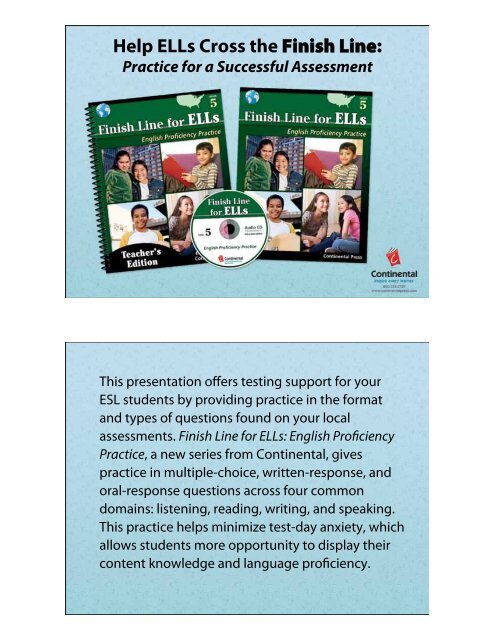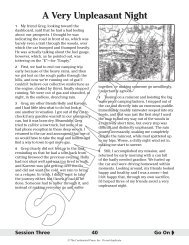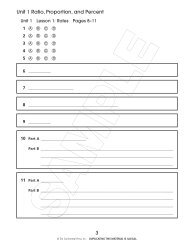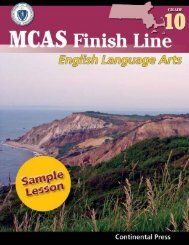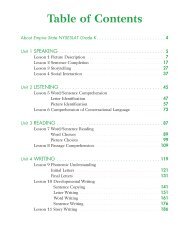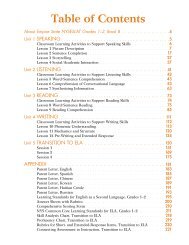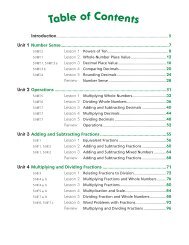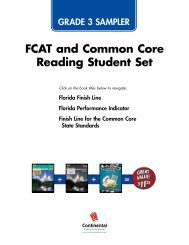Help Ells Cross the Finish Line: - Continental Press
Help Ells Cross the Finish Line: - Continental Press
Help Ells Cross the Finish Line: - Continental Press
You also want an ePaper? Increase the reach of your titles
YUMPU automatically turns print PDFs into web optimized ePapers that Google loves.
<strong>Help</strong> ELLs <strong>Cross</strong> <strong>the</strong> <strong>Finish</strong> <strong>Line</strong>:<br />
Practice for a Successful Assessment<br />
This presentation offers testing support for your<br />
ESL students by providing practice in <strong>the</strong> format<br />
and types of questions found on your local<br />
assessments. <strong>Finish</strong> <strong>Line</strong> for ELLs: English Proficiency<br />
Practice, a new series from <strong>Continental</strong>, gives<br />
practice in multiple-choice, written-response, and<br />
oral-response questions across four common<br />
domains: listening, reading, writing, and speaking.<br />
This practice helps minimize test-day anxiety, which<br />
allows students more opportunity to display <strong>the</strong>ir<br />
content knowledge and language proficiency.
Why do my students need<br />
support on testing format?<br />
• Many factors can hinder <strong>the</strong> achievement of<br />
ELLs. Students who are not fully acculturated<br />
to middle class mainstream values and beliefs<br />
may have differing attitudes towards gender<br />
roles, <strong>the</strong> individual versus <strong>the</strong> group or family,<br />
<strong>the</strong> use of time, and a host of o<strong>the</strong>r factors<br />
including a lack of familiarity with <strong>the</strong><br />
testing format. (Boals, 2003)<br />
Research also tells us:<br />
• The combination of <strong>the</strong>se three knowledge<br />
bases—knowledge of English, knowledge of<br />
<strong>the</strong> content topic, and knowledge of how<br />
tasks are to be accomplished—constitutes<br />
<strong>the</strong> major components of academic literacy.<br />
(Short, 1998)
More research related to<br />
Familiarity<br />
• Test location<br />
• Familiarity with test administrator<br />
• Words and phrases on assessment tasks that<br />
are not central to <strong>the</strong> assessed content (false<br />
cognates, technical vocabulary, idiomatic<br />
expressions)<br />
• Familiarity with task type/format. It is<br />
recommended that students be provided<br />
opportunity to practice understanding<br />
and responding to item types included in<br />
assessment. (Sato, 2009)<br />
Additional barriers for ELLs<br />
• Often <strong>the</strong> mainstream classroom teacher is not<br />
familiar with how an ELL is assessed; <strong>the</strong>refore<br />
<strong>the</strong>y are unsure how to tailor or model<br />
instruction appropriately.<br />
• Currently only a few states require classroom<br />
teachers to have at least minimal instructional<br />
development in teaching ELLs.
Also understand that<br />
during testing:<br />
• Students may not discuss what <strong>the</strong>y are writing,<br />
reading, listening or speaking about or ask for<br />
clarification if <strong>the</strong>y do not understand. The latter<br />
constraint is not common in most classroom<br />
settings, even during tests. Students may find<br />
<strong>the</strong> formality and strict rules of formal testing<br />
to be unnatural, frustrating, or even unkind.<br />
Preparing students for <strong>the</strong> unusual nature of<br />
a formal test is important to ease any anxiety.<br />
Written for students with developing proficiency levels, overlapping<br />
<strong>the</strong> intermediate, intermediate high, and advanced levels.<br />
Speaking unit uses adaptive questioning to<br />
move through five proficiency levels.
Content is typical at this grade level.<br />
Each unit has a Model Lesson to help students<br />
understand <strong>the</strong> question format and sequence.<br />
• Intermediate<br />
• Intermediate High<br />
• Advanced
Student Book<br />
Clear instructions on<br />
what to say and how to<br />
administer <strong>the</strong>se lessons<br />
will give teachers <strong>the</strong><br />
opportunity to put<br />
students in test-like<br />
conditions.<br />
Realistic, detailed artwork<br />
allows students to focus and<br />
understand <strong>the</strong> skill or<br />
question without being<br />
confused by poor<br />
representations.<br />
Teacher�s Edition
Teacher�s Edition<br />
Student Book<br />
Student Book<br />
Identifying <strong>the</strong><br />
Performance<br />
Objective gives<br />
teachers a clear<br />
understanding of<br />
<strong>the</strong> skill assessed.<br />
In this example, students<br />
analyze information to<br />
draw conclusions.<br />
Teacher�s Edition
Multiple-Choice Questions<br />
Listening<br />
• Listening for key words—before, after, probably do,<br />
most, labeled, best, how, where, example of, what,<br />
does not, which, why.<br />
• Use <strong>the</strong> audio component to take out bias in your voice<br />
or inflection of key words. �What does Elena do last?�<br />
• Because content is used, each question can become a<br />
teachable moment. Using <strong>the</strong> SIOP model, which requires<br />
much planning, each content-related question can be<br />
done before or after similar content is taught to <strong>the</strong><br />
student. This will help <strong>the</strong> student learn what to listen<br />
for and how to apply skills to selecting correct answers.<br />
The book does not have to be used sequentially.<br />
Bubble Scoring Sheet (practice)<br />
Students practice <strong>the</strong><br />
skill of transferring<br />
answers
Student Book<br />
Teacher�s Edition
Student Book<br />
Student Book<br />
Teacher�s Edition<br />
Teacher�s Edition
Student Book<br />
Extension activities for each language<br />
level provide additional classroom<br />
practice to support each lesson.<br />
Multiple-Choice Questions<br />
Reading<br />
Teacher�s Edition<br />
• Content questions include charts, timelines,<br />
graphs, and graphic organizers.<br />
• Skill-related questions for fact or opinion,<br />
inference, and cause and effect.<br />
• Reading for key words—illustrates, how,<br />
first, next, before, after, during, probably,<br />
happening, occurring, which detail, shows,<br />
describes, only, anything, about <strong>the</strong> same.<br />
• Emphasis on content vocabulary for Math,<br />
Science, and Social Studies.
Student Book<br />
Teacher�s Edition
Student Book<br />
Student Book
Teacher�s Edition<br />
Rubric helps students and<br />
teachers clarify what <strong>the</strong>y<br />
are responsible for on <strong>the</strong><br />
assessment. Similar to <strong>the</strong><br />
SIOP model of instruction,<br />
students need clear<br />
objectives.
Parent letters in multiple languages<br />
• Beginner<br />
• Intermediate<br />
• Intermediate High<br />
• Advanced<br />
• Advanced High
Student Book<br />
Teacher�s Edition
Student Book<br />
Student Book<br />
Questioning is adaptive so <strong>the</strong><br />
teacher can stop at any question<br />
once it becomes too difficult.<br />
Teacher�s Edition<br />
Teacher�s Edition
Annotated teacherʼs edition<br />
with instructional support<br />
Audio CD for listening units<br />
Review <strong>the</strong> rubric with<br />
students to remind <strong>the</strong>m<br />
of <strong>the</strong> proficiency levels<br />
and responsibility to<br />
elaborate on answers.<br />
Student book


